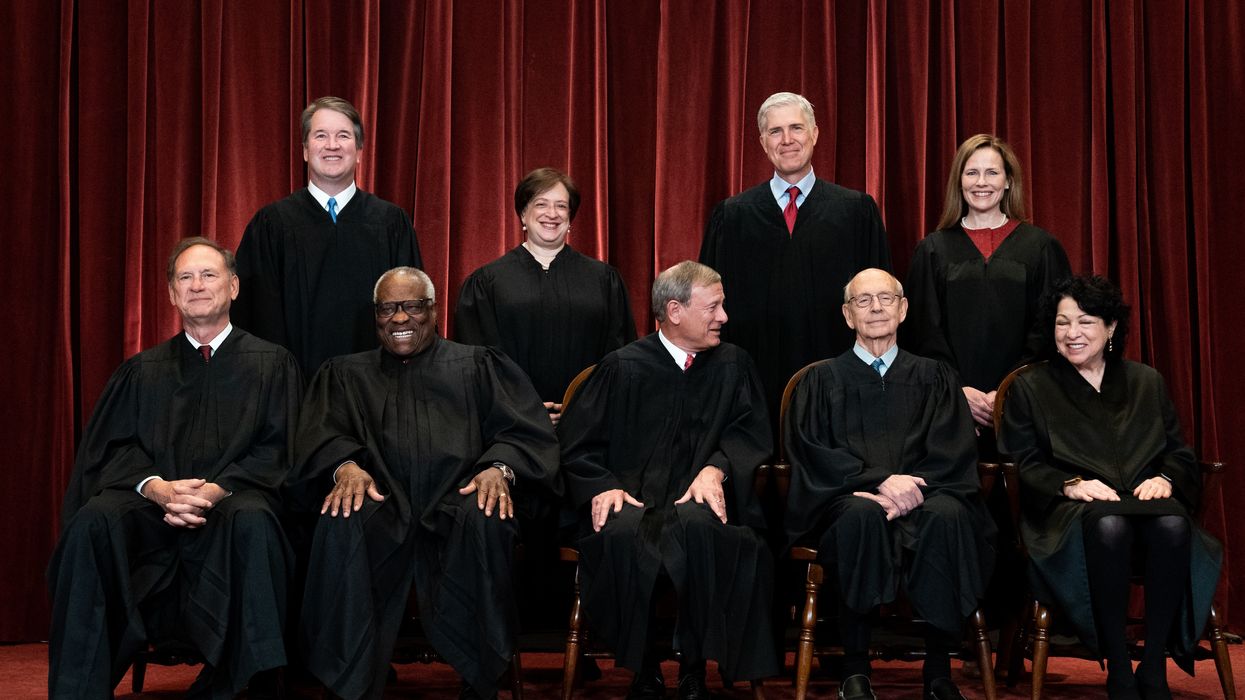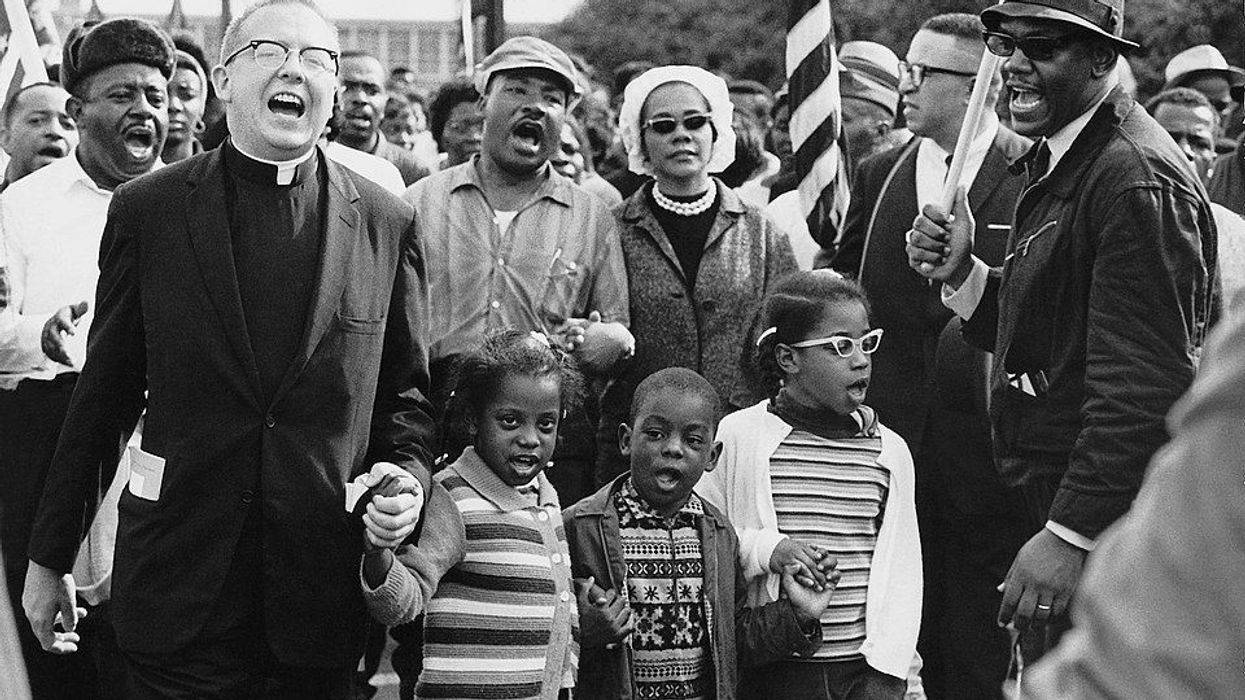Nine Justices in Black Who Rule White
The Supreme Court has been a bastion of white supremacy for generations. If it guts what remains of the Voting Rights Act, get ready to raise hell.
Fifty-seven years ago, I authored an article in the New York Times Magazine provocatively titled: “Nine Men in Black Who Think White.” It argued that the Supreme Court had long been one of the major roadblocks to progress on racial justice in this country.
Today, the nine black-robed Supreme Court justices include two Black justices, one Latina, and four women. Yet, all the evidence suggests that given the balance of forces on the court, they continue to “rule white,” undermining the dreams of a more racially just nation. Yes, three of the justices care deeply about racial justice, but they are only three of nine.
Next year, this Court is poised to further gut the signature piece of racial justice legislation of the last century, the Voting Rights Act of 1965. Movements across the nation need to make it clear to the world that this is unacceptable.
Those of us who share dream that our Declaration of Independence and Constitution would help create a country and legal system dedicated to liberty and equality have, for most of the nation's history, been sorely disappointed.
The Supreme Court and Segregation
Yes, the Supreme Court briefly awakened to the “Equal Justice Under Law” motto engraved into its entrance with its famous 1954 decision in Brown v. Board of Education. In this decision, the court signaled the death knell of legalized racial segregation by rendering such segregation in public schools unconstitutional. Three cheers. But then it returned to its old habits right up to this current dangerous moment in history.
First a little background.
Rarely has the United States Supreme Court paid much attention to this country's Declaration of Independence and its stirring statement that all men are created equal. Instead, our forefathers built slavery into our legal system, adding a clause allowing for the nation's slaves to be counted as three-fifths of a person for purposes of representation in Congress.
After our bloody Civil War, with Northerners in control of Congress, the United States passed strong equal rights constitutional amendments during the period known as Reconstruction. But that era proved short-lived.
It will come as little surprise that the Supreme Court has spent much of the ensuing six decades after the passage of the Civil Rights and Voting Rights acts weakening key parts of both.
In 1874, the Supreme Court struck down key sections of these laws, leaving Southern states in control of race relations as soon as Congress ended Reconstruction two years later. This opened the doors for Southern politicians and a resurgent Ku Klux Klan to terrorize the freed slaves and Southern politicians to retake control of Southern states and local governments and their local law enforcement apparatus and return property and plantations to former white owners.
Then, in its 1896 Plessy v. Ferguson ruling, the Supreme Court fully codified Jim Crow, establishing the so-called “separate but equal” doctrine (in this case, segregated railway cars were ruled legal so long as they were “equal”).
As bad as that was, it turned out even worse as Southern states largely ignored the “equal" part, giving the nation what amounted to a judicial seal of approval on Southern segregation.
Turning Back the Clock
Many believe that this era ended in 1954 with the historic Brown v. Board of Education ruling, in which the Supreme Court declared that “separate but equal” was unconstitutional in public schools. At that time, schools across the entire South, from Maryland and Delaware to Texas, were segregated.
Yet in my 1968 “Nine Men in Black” piece, I argued that the 1954 decision was a lone beacon of legal hope surrounded by decades of racist rulings, both before and after that decision. Just one year after the Brown decision, in 1955, the court ruled that Southern public schools needed time to figure out how to integrate.
Today, in both North and South, many schools are still largely segregated, and the Supreme Court and most lower courts have given up seeking workable court orders. Put simply, “more time” turned into endless time, and Black students have continued to suffer the results.
Starting in the early 1930s, the legendary legal genius Thurgood Marshall joined the NAACP’s legal team as the organization built its early Southern school desegregation work. The team executed its case-by-case strategy, leading up to the Brown ruling in 1954. These cases led to many successful outcomes, which changed the reach of the separate but equal doctrine. Marshall then led the team that won the Brown case.
Yet, when Marshall was appointed to the Supreme Court himself 13 years after the Brown decision, his crusade to end racial injustices hit roadblock after roadblock. The court greeted Marshall's appointment with two devastating 5-4 opinions. The first involved the NAACP's attempt to address whites who had fled across state lines to avoid integrating schools in their original state or in their new state. The second case involved Texas, where the legislature established school districts that placed low-income students, mostly Black students, in poorly performing schools.
Two Interwoven Histories
As Howard Zinn reminds us in his powerful People’s History of the United States, our nation has always had two forces that shape history, inextricably interwoven.
One consists of the powerful, but the second consists of those who have opposed the powerful. Most history is written uncritically about the former, the people and corporations and government institutions that have oppressed people in this country and around the world. But equally important has been the second strand, the social movements that have risen in opposition to fight for people and justice and the environment.
Few movements have been as powerful as the civil rights movement, which Marshall and Ella Baker and A. Philip Randolph and others helped get off the ground in the 1930s. The movement gained momentum after the 1954 Brown decision, even in the face of the murders of leaders like Martin Luther King Jr., Medgar Evers, and the Kennedy brothers, as well as volunteers, by killers that included police and sheriffs.
Fight like hell to write and pass replacement statutes even better than what the current administration and its followers have destroyed.
Yet the movement’s marches and protests and the countless jail terms of its leaders culminated in two landmark pieces of legislation: the Civil Rights Act of 1964 and the Voting Rights Act of 1965. This period is often referred to as the Second Reconstruction.
The Civil Rights Act outlawed discrimination based on race, color, religion, sex, or national origin in public places, employment, and federally funded programs. The Voting Rights Act the following year prohibited racial discrimination in voting, massively increasing voter turnout and voter registrations, particularly among Black people.
I got a deep sense of the power of the civil rights movement and the obstacles it faced in 1963. After graduating from law school, I volunteered to work on the overworked, minuscule legal staff of the NAACP, under the renowned Robert L. Carter, participant with Thurgood Marshall in the Brown case.
Testing me, he immediately sent me to Baton Rouge, Louisiana, where I slept for safety on the floor between beds in a Black motel. In New York, Carter assigned me to a difficult Northern public school class action case, where the judge implied the reason why Black students assigned to a virtually all-Black school did not do well was due to their intelligence level. Litigating before these judges was quite an eye opener. But the power of the civil rights movement, with Northerners working with Southerners, Blacks with whites, was imprinted on my soul.
Prepare to Raise Hell
It will come as little surprise that the Supreme Court has spent much of the ensuing six decades after the passage of the Civil Rights and Voting Rights acts weakening key parts of both.
The one that today stands dangerously close to emasculation is the Voting Rights Act of 1965. It was already seriously eroded by the Supreme Court decisions in 2013 and 2021.
Then, this fall, the Supreme Court heard a case, Louisiana v. Callais, that threatens to erase much of Section 2 of the act, one of the few tools we still have to prevent racial gerrymandering and voter suppression. The reports from the oral arguments before the Supreme Court in October suggested the court is likely to rule in 2026 to weaken Section 2.
With such a ruling, as former Georgia state representative Stacey Abrams put it in The Atlantic: “We will not have free and fair elections in this country going forward” because “for the vast majority of people of color in this country, you will not be permitted to have access to a truly representative democracy.”
As we fight back, we should all be inspired by Supreme Court Justice Thurgood Marshall’s words in 1992, after he had dissented on hundreds of Supreme Court rulings between 1967 and 1991:
We must dissent from the indifference. We must dissent from the apathy. We must dissent from the fear, the hatred, the mistrust. We must dissent from a nation that has buried its head in the sand, waiting in vain for the needs of its poor, its elderly, and its sick to disappear and just blow away.
We should listen to Bishop William Barber, who has mobilized tens of thousands of people through the Poor People’s Campaign and Repairers of the Breach. Bishop Barber has kept his attention solidly focused on building movements that link the South with the North. He has called for a Third Reconstruction, which has been encapsulated in a Congressional Resolution to end systemic racism and poverty, as well as militarism and environmental destruction.
For those of you who worked hard to pass the Civil Rights and Voting Rights Acts, for those of you who have just joined the fight for racial justice, I say this. Forget your sadness and your despair. Fight like hell to write and pass replacement statutes even better than what the current administration and its followers have destroyed.
Raise hell if the Supreme Court further guts the Voting Rights Act. Dare to dream of and build a world without discrimination.


